Lawrence Justinian
Saint Lawrence Justinian | |
|---|---|
Episcopal vestments | |
| Patronage | Patriarchate of Venice |
| Shrines | Basilica of San Pietro di Castello |
Lawrence Justinian (Italian: Lorenzo Giustiniani, 1 July 1381 – 8 January 1456) was a Venetian Catholic priest and bishop who became the first Patriarch of Venice. He is venerated as a saint by the Catholic Church.
Biography
Lawrence Justinian was a member of the well-known
Lawrence promoted the Constitutions which had been established for the
In 1433,
It was during Lawrence's rule that
Veneration
-
St. Lawrence Giustiniani adoring the Baby Jesus, by Luca Giordano, (17th century).
-
Lorenzo Giustiniani. 1465. Gallerie dell'Accademia, Venice, by Gentile Bellini
-
De disciplina et perfectione monasticae conversationis
-
Statue of Saint Lawrence Justinian in theCathedral of Padua
He died on January 8, 1456, in Venezia Italy. He was proclaimed saint on October 16, 1690 by Pope Alexander VIII, at the presence of Cardinal Pietro Ottoboni as procurator, assisted by Cardinal Carpegna, and of Abbot Pier Santi Fonti in quality of master of ceremonies.[5][6] The Bull of Canonization was published on 4 June 1724 by Pope Benedict XIII.[7]
His works, consisting of
See also
- Louis Barbo
References
- ^ Saint of the Day, September 5 saintpatrickdc.org. Retrieved 2012-02-29.
- ^ a b "San Lorenzo Giustiniani". Santi e beati (in Italian). Retrieved 19 January 2013.
- ^ "Saints of the Canons Regular". Confederation of Canons Regular of St. Augustine. Archived from the original on 23 September 2015. Retrieved 19 January 2013.
- ^ "Congregations and Houses". Augustinian canons. Retrieved 16 February 2013.
- OCLC 56014539.
- ^ The Oblations in the Old Rite of Canonisation. Archived from the original on February 19, 2014. (at 1:29).
- ^ [https://archive.org/details/BR-Tomo-22 Bullarium Romanum. Vol 22. Benedict XIII (1724-1730). Taurini Ed, 1871. P. 23-31.
- ^ Calendarium Romanum, Libreria Editrice Vaticana (1969), p. 137
- ISBN 88-209-7210-7
- ^ Chisholm, Hugh, ed. (1911). . Encyclopædia Britannica. Vol. 12 (11th ed.). Cambridge University Press. pp. 54–55.
External links
![]() This article incorporates text from a publication now in the public domain: Herbermann, Charles, ed. (1913). "Lawrence Justinian". Catholic Encyclopedia. New York: Robert Appleton Company.
This article incorporates text from a publication now in the public domain: Herbermann, Charles, ed. (1913). "Lawrence Justinian". Catholic Encyclopedia. New York: Robert Appleton Company.




